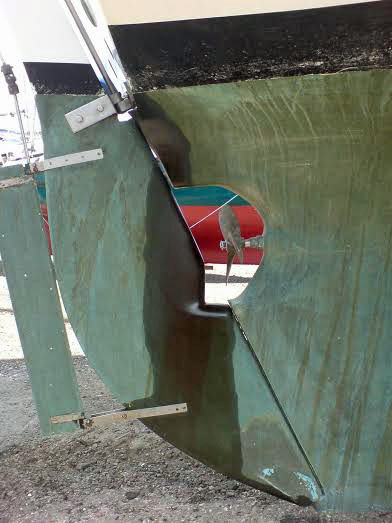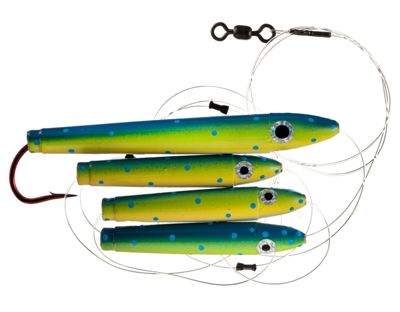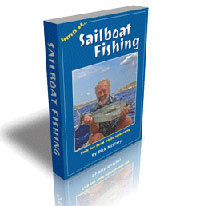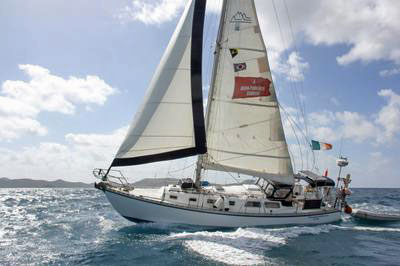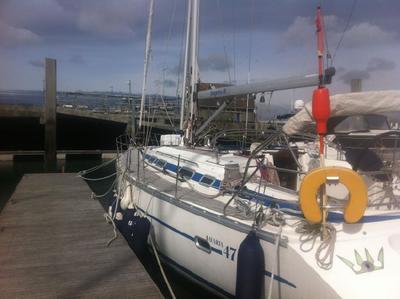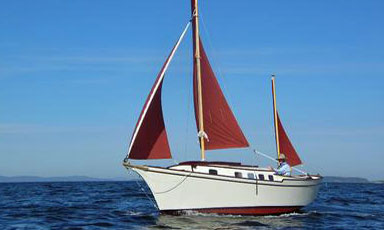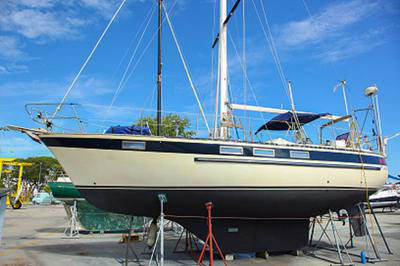| Back to Back Issues Page |
 |
|
The Sailboat Cruiser ~ Issue #30 August 09, 2016 |
HiThe Sailboat CruiserThe Sailboat Cruiser is the free monthly newsletter of sailboat-cruising.com and sets out to bring you the news, views and general musings of, well, me - Dick McClary, a sailboat cruiser and creator/owner of the website. If you like this newsletter, please feel free to email it to your friends. If one of your friends did forward this to you and you like what you read, please subscribe by visiting The Sailboat Cruiser Newsletter #30 - August 2016What's in This Issue:
It's a Small WorldWith 'Alacazam' safely (we hope) tucked up ashore in Antigua, we were having a quiet Sunday-afternoon beer with our pals back home at the Tamar River Sailing Club. We were absently watching a cruising yacht anchoring in front of the club. Soon the crew of two approached us..."Any chance of a beer and a shower?" they asked. "Of course, but haven't we met before?" said Mary. And it turned out we had - just a couple of months previously at a yachties beach bar in Dominica, West Indies. They were fellow Ocean Cruising Club members Mike and Nicki Reynolds on Zen Again from Australia who were on their way around the world. Burgees were exchanged in the traditional manner - their FYC (Freemantle Yacht Club) for our TRSC one. An amazing coincidence, particularly as they had got here over thousands of miles of ocean and we had arrived courtesy of Virgin Atlantic. 'Zen Again's blog is
Zen Again Blogspot.
Happy Returns!There were two other notable arrivals at the TRSC in July - the diminutive canoe-sterned 'Godot' and the famous 'Jester', both having successfully completed the 2016 Jester Azores Challenge.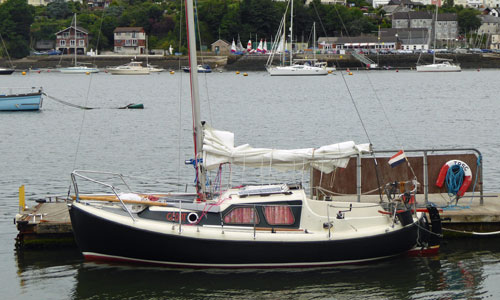 'Godot', a
Nordica 20
skippered by owner Olivier Delebecque, is currently on her way home to Amsterdam - singlehanded of course!
'Godot', a
Nordica 20
skippered by owner Olivier Delebecque, is currently on her way home to Amsterdam - singlehanded of course!
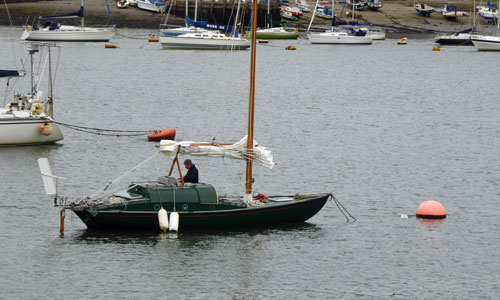 'Jester' skippered by owner Trevor Leek is a replica of the original yacht of this name which was lost in the Atlantic in 1988.
'Jester' skippered by owner Trevor Leek is a replica of the original yacht of this name which was lost in the Atlantic in 1988.
What's That Boat?Remember last month's mystery boat? Well, that was identified by Daniel Grenier as a Jeanneau 47. It's from their 'Sun Odyssey' range and was designed by Philippe Briand. Thanks Daniel - a pic of the boat now heads the list of 45' to 50' cruising boats.Wind Vane WobblesFellow TRSC member Jon Dunsdon tells me about an issue he has with the Auto-Steer trim-tab self-steering gear he has on his 25ft, wood-epoxy Vertue, 'Hippo'.
Jon says... "The system mostly works very well and I rarely helm the yacht as soon as it is practicable to use the windvane. There is one condition where I find the wind vane doesn't work at all well and that is beating into short chop. Jon suspects the problem's caused by the water velocity reversal after the wave has passed added to the tidal stream is greater than the slowed boat speed causing the tiller to flop around. He asked me if I had any ideas... Well, I've not experienced any similar problem with my Aries Servo-Pendulum Gear but it did occur to me that the trim tab could be stalling, quite possibly for the reason he suggests, leading to the interaction of the windvane and the trim tab getting out of synchronization causing the rudder to hunt from side to side. Or maybe the leading edge of the trim tab should more closely follow the trailing edge of the rudder, the cause of the problem being the turbulence between the two in the situation that Jon describes? Do you good people have any ideas which might help John find a solution to his windvane wobbles? If so please drop him a line at hippo213@btinternet.com.
This Month's Sailboat Fishing TipOne of the easiest ways to get a fish interested in the lure you're trolling astern is to use a daisy chain. A daisy chain is simply a string of hookless lures (three of them in the pic above) rigged together line-astern ahead of your trolling lure.The hookless lures are known as teasers, and their purpose is to create additional visual attraction and sonic disturbance in the water. The intention is to persuade a curious predator that it’s come across a small shoal of baitfish (the teasers) pursued by a chaser (your lure, the one with the hook) not looking in his rear-view mirror. It won’t take a great leap of imagination to guess which one’s going to get hit! The one illustrated is my all-time favourite - a cedar plug daisy chain.
For more sailboat fishing tips like this one, download my eBook...
Creating a Dripless Stuffing BoxMany thanks to Chris Collins, who submitted the following article...Modern dripless propeller shaft seals work great, but they can be expensive. If they fail, they cannot be serviced without a haul-out. Some ocean cruisers report this to be a disadvantage, preferring the ability to replace the packing in their stuffing boxes while at sea. I suggest that none of us like having seawater leak into our bilge. 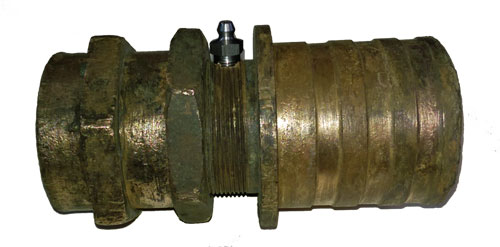
Our ketch had sat, and does sit for months without the engine running. The previous owner had replaced the propeller shaft, and yet I found it corroded under the packing. This was a classic case of being wet with saltwater and lacking oxygen. Chris Collins owns, sails, and maintains a Catalina 30 on El Dorado Lake in Kansas and a 45 foot ketch in Rockport, Texas.
Used Sailing Gear & EquipmentIt's always worth taking a look at what our visitors are getting rid of. Remember one mans junk is another man's gold!Among other stuff this month, we have a
Tasar Sailing Dinghy.
Cruising Boats for SaleIf you're thinking of selling your cruising boat - or know someone who is - remember you can advertise it entirely free of charge on sailboat-cruising.com - which is what the owners of these boats have done.Just click on the pics to see the full details...
'Transcendence' a Cascade 36'Empress III' a Bavaria 47 Exclusive'SailAbout', a Unique Pocket Cruiser'Jack Iron', a Corbin 39 Centre Cockpit CruiserTake a look at what other secondhand cruising boats are currently for sale... Don't forget...If you're thinking of looking at a secondhand sailboat, or just want to be aware of what to look for - and when to walk away no matter what - then you really ought to take a look at Andrew Simpson's eBook Secrets of Buying Secondhand Boats...It's full of sound advice from an acknowleged expert and could quite literally save you $$$$$thousands! More 'Likes' Please Sailboat-Cruising.com has a Facebook Page!
Sailboat-Cruising.com has a Facebook Page!
Clicking the image here will take you right to it, where you can browse through many more posts and articles. Please take a look, and feel free to make a post - and don't forget to 'Like' us of course... Thanks! Visit sailboat-cruising.com's Facebook Page... And finally...If you know anyone who might be interested in the contents of this newsletter, feel free to email it to them. It's not secret!And this newsletter can be a two-way thing. If you've read anything you'd like to comment on, or perhaps there's an event you'd like to see announced in a future newsletter, then please let me know. See you next month! 
Go to Sailboat-Cruising.com's Home Page... |
| Back to Back Issues Page |
